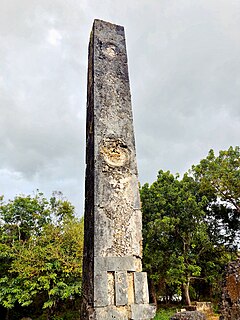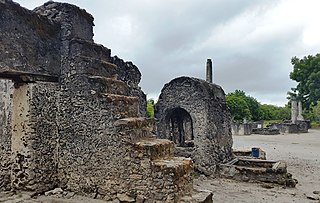
Kilwa Kisiwani is an island, national historic site, and hamlet community located in the township of Kilwa Masoko, the district seat of Kilwa District in the Tanzanian region of Lindi Region in southern Tanzania. Kilwa Kisiwani is the largest of the nine hamlets in the town Kilwa Masoko and is also the least populated hamlet in the township with less than 1,000 residents. At its peak Kilwa hosted over 10,000 inhabitants in the Middle Ages. Since 1981 the entire island of Kilwa Kisiwani has been designated by UNESCO as a World Heritage Site along with the nearby ruins of Songo Mnara. Despite its significant historic reputation, Kilwa Kisiwani is still home to a small and resilient community of native residents that have inhabited the island for centuries. Kilwa Kisiwani is one of the seven World Heritage Sites located in Tanzania. Additionally, the site is a registered National Historic Site.

Lindi Region is one of Tanzania's 31 administrative regions. The region covers an area of 66,040 km2 (25,500 sq mi). The region is comparable in size to the combined land area of the nation state of Sri Lanka. The regional capital is the municipality of Lindi. The Lindi Region borders on Pwani Region, Morogoro Region, Ruvuma Region, and Mtwara Region. The name Lindi is an old Swahili word meaning "hidding pits", a place where Swahili people will hide to defend themselves from hostile invasions. The region is home to two UNESCO World Heritage Sites, namely; Kilwa Kisiwani and Selous Game Reserve. According to the 2012 national census, the region had a population of 864,652, which was lower than the pre-census projection of 960,236. For 2002–2012, the region's 0.9 percent average annual population growth rate was the 29th highest in the country. It was also the least densely populated region with 13 people per square kilometer.

The Tongoni Ruins are a 15th century Swahili ruins of a mosque and forty tombs located in Tongoni ward in Tanga District inside Tanga Region of Tanzania. The area was a different place four to five centuries ago. Contrary to its almost unnoticed presence today, it was a prosperous and a respected Swahili trading centre during the 15th century. Most of the ruins are still not yet been uncovered. The site is a registered National Historic Site.

Mikindani is a historic coastal town located in Mtwara-Mikindani District of Mtwara Region in Tanzania. The name comes from the Swahili word mikinda which means "young coconut trees". Therefore the term "Mikindani', literally means "the place where there are young coconut trees" in old Swahili language. Mikindani is part of the city of Mtwara and is governed by the Mtwara Mikindani Municipal Council. The site is a registered National Historic Site.

The Kizimkazi Dimbani Mosque is a mosque Located in the town of Dimbani, Kusini District of Unguja South Region in Tanzania. It is situated on the southern tip of the island of Zanzibar in Tanzania and is one of the oldest Islamic buildings on the East African coast. Despite its name, it is located in Dimbani, not Kizimkazi, which is 3 miles away. According to a preserved kufic inscription, it was built in 1107. Although the inscription and certain coral-carved decorative elements date from the period of construction, the majority of the present structure was rebuilt in the 18th century.

Tumbatu is historic Swahili settlement located on Tumbatu Island, Kaskazini A District of Unguja North Region in Tanzania. This site is a significant archaeological site that contains a large number of collapsed coral stone structures including private houses and several mosques, the largest of which is located on the shore facing the village of Mkokotoni on Unguja. Pearce initially looked into the ruins in 1915 and wrote about the mosques, palace, and other stone homes.

Kaole is a national historic site located in Bagamoyo District of Pwani Region in Tanzania. The site is located three miles east of the historic city of Bagamoyo on the Indian Ocean coast. The area contains old Swahili coral stone ruins dating to a period between the 13th century and the 16th century. Some of the ruins date back to the 13th century and consist of two mosques and 30 tombs.

Songo Mnara is a historic Swahiili settlement in located on Songo Mnara Island in Pande Mikoma, Kilwa District in Lindi Region of Tanzania. The island is home to a Medieval Swahili stone town. The stone town was occupied from the 14th to 16th centuries. Songo Mnara has been recognized as a UNESCO World Heritage Site, along with nearby stone town Kilwa Kisiwani. In total, archaeologists have found six mosques, four cemeteries, and two dozen house blocks along with three enclosed open spaces on the island. Songo Mnara was constructed from rough-coral and mortar. This stonetown was built as one of many trade towns on the Indian Ocean. The site is a registered National Historic Site.

Kilwa Kivinje Historic Site is protected historic site located on Kilwa Kivinje ward in Kilwa District in Lindi Region of Tanzania's Indian Ocean coast. The site is home to medieval Swahili ruins and some surviving Swahili buildings from the late 19th century. The settlement is considered to be the refuge of the earlier inhabitants of Kilwa Kisiwani who had fled Vasco da Gama sacking of the city in 1505 and also absorbed more refugees fleeing the Madagascar pirates in 1822.

Pujini Ruins is a Medieval historic site next to the village of Pujini located in Chake Chake District of Pemba South Region. There used to be a fortified palace at the site, only ruins of the walls remain. The palace is believed to have been of Mkame Mdume. Its one of several National Historic Sites on the island of Pemba including Chambani and Ras Mkumbuu.

Chwaka is a Medieval Swahili historic site next to the village of Chwaka located in Micheweni District of Pemba North Region. There is an excavated Swahili mosque on the site. The location of these ruins is 6 km from the small town of Konde, at the end of a trail that extends 900 meters in the direction of the village of Tumbe on the way to the village of Myumoni.
Mtambwe Kuu or Mtambwe Mkuu is a Medieval Swahili historic site located in Chake Chake District of Pemba North Region. A town wall, a mosque, tombs, and residences are among the several stone constructions at the Mtambwe Mkuu site in northwest Pemba. The oldest indications of occupation date from the eleventh century and persisted successfully and unbrokenly until the fifteenth century. It was once again occupied in the nineteenth century. A cache of over 2,000 gold and silver coins from the 10 and eleventh centuries were found during an excavation at the location, demonstrating Pemba's Swahili involvement in the regional trade networks at the time.
Tumbe is an early Medieval Swahili historic site next to the village of Tumbe located in Micheweni District of Pemba North Region. Between 600 and 1000 AD, the city of Tumbe served as the island's primary location. There is sufficient evidence that this city served as a major commerce hub for the Indian Ocean. Smaller sites from the eighth to tenth centuries AD were grouped together around the major metropolis.
Shamiani is protected historic site located inside Mkoani District of Pemba South Region in Tanzania. The site is home to partially excavated abandoned medieval Swahili ruins with a brief occupation period from about 14th to 16th century.

Msuka Mjini Ruins is protected historic site located inside Micheweni District of Pemba North Region in Tanzania. Msuka Mjini has a Swahili mosque from the fifteenth century preserved in ruins on the Kigomasha peninsula on the island. The date 816AH is carved on the interior of the circular mirhab.
Mduuni Ruins is protected historic site located inside Micheweni District of Pemba North Region in Tanzania. The settlement was established around 1100 CE.
Mkia wa Ng'ombe Ruins is protected historic site located inside Micheweni District of Pemba North Region in Tanzania. The settlement was established around the 15th CE and abandoned in the 16th century. There are ruins of a mosque, tombs and some stone buildings. The site is critically endangered to further erosion.
Kisimani Mafia is a national historic site located in Mafia District of Pwani Region. They are Mafia's oldest ruins, which are close to Kilindoni. The earliest strata of mosques, according to archaeologist Neville Chittick who performed excavations there in the 1950s, date from about the tenth and eleventh centuries. However, many of them have since been washed into the sea.
Bweranyange is historic settlement located inside Karagwe District of Kagera Region in Tanzania. The settlement was established as the capital of the Karagwe Kingdom. The site is a registered National Historic Site.

Kunduchi is a Medieval Swahili historic site in Kunduchi ward, located in Kinondoni District of Dar es Salaam Region. There is an excavated 15th-century mosque on the site. An 18th-century cemetery with the biggest collection of pillared tombs in East Africa, situated in a baobab woodland, and embellished with Ming era's porcelain plates. The pottery discovered here demonstrates the medieval town's affluence and trading connections with imperial China.

















